Boeing 707

Boeing 707

| Boeing 707 | |
|---|---|
| Former Qantas 707-138B then owned by John Travolta at the 2007 Paris Air Show | |
| Role | Narrow-body jet airliner |
| National origin | United States |
| Manufacturer | Boeing Commercial Airplanes |
| First flight | December 20, 1957[8] |
| Introduction | October 26, 1958, with Pan American World Airways |
| Retired | 2019 (commercially) |
| Status | In limited military service |
| Primary users | Pan Am (historical) Trans World Airlines (historical) American Airlines (historical) Air France (historical) |
| Produced | 1957–1979 |
| Number built | 865 (excludes Boeing 720s)[9] |
| Unit cost | |
| Developed from | Boeing 367-80 |
| Variants | Boeing 720 Boeing C-137 Stratoliner |
| Developed into | Boeing E-3 Sentry Boeing E-6 Mercury Northrop Grumman E-8 Joint STARS |
The Boeing 707 is an American mid-sized, mid- to long-range, narrow-body, four-engine jet airliner built by Boeing Commercial Airplanes from 1958 to 1979. Versions of the aircraft have a capacity from 140 to 219 passengers and a range of 2,500 to 5,750 nautical miles (2,880 to 6,620 mi; 4,630 to 10,650 km).[12]
Developed as Boeing's first jet airliner, the 707 is a swept-wing design with podded engines. Although it was not the first jetliner in service, the 707 was the first to be commercially successful. Dominating passenger air transport in the 1960s and remaining common through the 1970s, the 707 is generally credited with ushering in the Jet Age.[13][14] It established Boeing as one of the largest manufacturers of passenger aircraft, and led to the later series of airliners with "7x7" designations. The later 720, 727, 737, and 757 share elements of the 707's fuselage design.
The 707 was developed from the Boeing 367-80, a prototype jet first flown in 1954. A larger fuselage cross-section and other modifications resulted in the initial-production 707-120, powered by Pratt & Whitney JT3C turbojet engines, which first flew on December 20, 1957. Pan American World Airways began regular 707 service on October 26, 1958. Later derivatives included the shortened long-range 707-138, "hot and high" 707-220 and the stretched 707-320, all of which entered service in 1959. A smaller short-range variant, the 720, was introduced in 1960. The 707-420, a version of the stretched 707 with Rolls-Royce Conway turbofans, debuted in 1960, while Pratt & Whitney JT3D turbofans debuted on the 707-120B and 707-320B models in 1961 and 1962, respectively.
The 707 has been used on domestic, transcontinental, and transatlantic flights, and for cargo and military applications. A convertible passenger-freighter model, the 707-320C, entered service in 1963, and passenger 707s have been modified to freighter configurations. Military derivatives include the E-3 Sentry airborne reconnaissance aircraft and the C-137 Stratoliner VIP transports. A total of 865 Boeing 707s were produced and delivered along with over 800 military versions.
| Boeing 707 | |
|---|---|
| Former Qantas 707-138B then owned by John Travolta at the 2007 Paris Air Show | |
| Role | Narrow-body jet airliner |
| National origin | United States |
| Manufacturer | Boeing Commercial Airplanes |
| First flight | December 20, 1957[8] |
| Introduction | October 26, 1958, with Pan American World Airways |
| Retired | 2019 (commercially) |
| Status | In limited military service |
| Primary users | Pan Am (historical) Trans World Airlines (historical) American Airlines (historical) Air France (historical) |
| Produced | 1957–1979 |
| Number built | 865 (excludes Boeing 720s)[9] |
| Unit cost | |
| Developed from | Boeing 367-80 |
| Variants | Boeing 720 Boeing C-137 Stratoliner |
| Developed into | Boeing E-3 Sentry Boeing E-6 Mercury Northrop Grumman E-8 Joint STARS |
Development
Model 367-80 origins
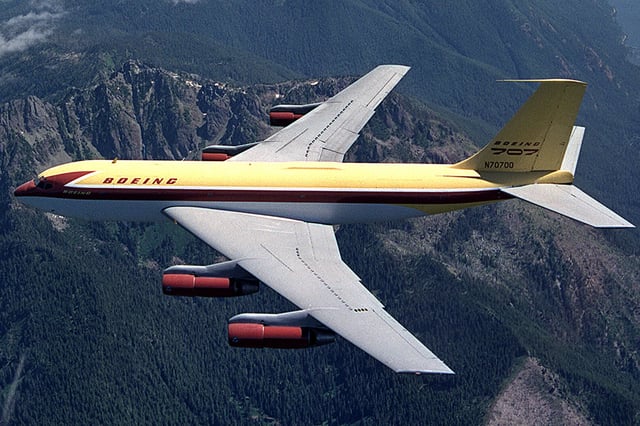
The 707 was based on the Dash 80.
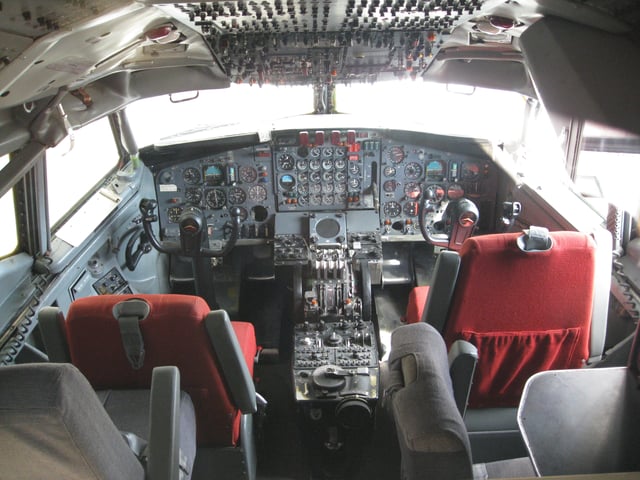
Boeing 707-123B cockpit
During and after World War II, Boeing was known for its military aircraft. The company had produced innovative and important bombers, from the B-17 Flying Fortress and B-29 Superfortress, to the jet-powered B-47 Stratojet and B-52 Stratofortress. The company's civil aviation department lagged far behind Douglas and other competitors, the only noteworthy airliners being the Boeing 314 Clipper and 307 Stratoliner. During 1949 and 1950, Boeing embarked on studies for a new jet transport, realizing that any design must be aimed at both the military and civilian markets. At the time, aerial refueling was becoming a standard technique for military aircraft, with over 800 KC-97 Stratofreighters on order. With the advent of the Jet Age, a new tanker was required to meet the USAF's fleet of jet-powered bombers; this was where Boeing's new design would potentially win military orders.[15]
Boeing studied numerous wing and engine layouts for its new transport/tanker, some of which were based on the B-47 and C-97, before settling on the 367-80 quadjet prototype aircraft. The "Dash 80" took less than two years from project launch in 1952 to rollout on May 14, 1954, then first flew on July 15, 1954. It was powered by the Pratt & Whitney JT3C turbojet engine, which was the civilian version of the J57 used on many military aircraft of the day, including the F-100 Super Sabre fighter and the B-52 bomber. The prototype was a proof-of-concept aircraft for both military and civilian use. The United States Air Force was the first customer, using it as the basis for the KC-135 Stratotanker aerial refueling platform.
Whether the passenger 707 would be profitable was far from certain. At the time, Boeing was generating nearly all of its revenue from military contracts: Its last passenger transport, the Boeing 377 Stratocruiser, had netted the company a $15 million loss before it was purchased by the Air Force as the KC-97 Stratofreighter.[16] In a demonstration flight over Lake Washington outside Seattle, on August 7, 1955, test pilot Tex Johnston performed a barrel roll in the 367-80 prototype.[17]
The 132 in (3,352.80 mm) wide fuselage of the Dash 80 was large enough for four-abreast (two-plus-two) seating like the Stratocruiser. Answering customers' demands and under Douglas competition, Boeing soon realized this would not provide a viable payload, so it widened the fuselage to 144 in (3,660 mm) to allow five-abreast seating and use of the KC-135's tooling.[18] Douglas Aircraft had launched its DC-8 with a fuselage width of 147 in (3,730 mm). The airlines liked the extra space and six-abreast seating, so Boeing increased the 707's width again to compete, this time to 148 in (3,760 mm).[19]
Production and testing

Members of the joint FAA and Boeing team performing test flight on the Boeing 707 during certification process in April 15, 1958: From left to right: Joseph John "Tym" Tymczyszyn (FAA), Lew Wallich (Boeing), unknown, unknown
The first flight of the first-production 707-120 took place on December 20, 1957, and FAA certification followed on September 18, 1958.[20] Both test pilots Joseph John "Tym" Tymczyszyn and James R. Gannett were awarded the first Iven C. Kincheloe Award for the test flights that led to certification.[21] A number of changes were incorporated into the production models from the prototype. A Krueger flap was installed along the leading edge between the inner and outer engines on early 707-120 and -320 models.[10][22]
Further developments
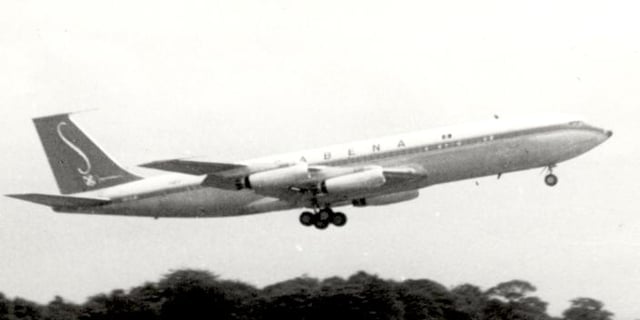
Early production Boeing 707–329 of Sabena in April 1960 with the original short tail-fin and no ventral fin
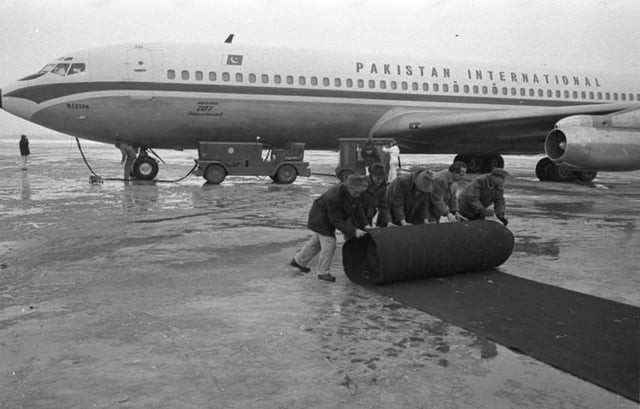
A Pakistan International Airlines Boeing 707 at Munich-Riem Airport during the state visit of Pakistan President Ayub Khan to Germany, January 1961
The initial standard model was the 707-120 with JT3C turbojet engines. Qantas ordered a shorter-bodied version called the 707-138, which was a -120 with six fuselage frames removed, three in front of the wings, and three aft. The frames in the 707 were each 20 in (510 mm) apart, so this resulted in a net shortening of 10 ft (3.0 m) to 134 ft 6 in (41.0 m). Because the maximum takeoff weight remained the same as that of the -120 (247,000 lb (112 t)), the -138 was able to fly the longer routes that Qantas needed.[22] Braniff International Airways ordered the higher-thrust version with Pratt & Whitney JT4A engines, the 707-220. The final major derivative was the 707-320, which featured an extended-span wing and JT4A engines, while the 707-420 was the same as the -320, but with Conway turbofan engines. British certification requirements relating to go-arounds with one engine inoperative also forced Boeing to increase the height of the tail fin on all 707 variants, as well as add a ventral fin, which was retrofitted on earlier -120 and -220 aircraft. These modifications also aided in the mitigation of Dutch roll by providing more stability in yaw.
Though initially fitted with turbojet engines, the dominant engine for the Boeing 707 family was the Pratt & Whitney JT3D, a turbofan variant of the JT3C with lower fuel consumption and higher thrust. JT3D-engined 707s and 720s were denoted with a "B" suffix. While many 707-120Bs and -720Bs were conversions of existing JT3C-powered machines, 707-320Bs were available only as newly built aircraft, as they had a stronger structure to support a maximum takeoff weight increased by 19,000 lb (8,600 kg), along with modifications to the wing. The 707-320B series enabled nonstop westbound flights from Europe to the US West Coast and from the US to Japan.
The final 707 variant was the 707-320C, (C for "Convertible"), which had a large fuselage door for cargo. It had a revised wing with three-sectioned leading-edge flaps, improving takeoff and landing performance and allowing the ventral fin to be removed (although the taller fin was retained). The 707-320Bs built after 1963 used the same wing as the -320C and were known as 707-320B Advanced aircraft.
Production of the passenger 707 ended in 1978. In total, 1,010 707s were built for civilian use, though many of these found their way to military service. The 707 production line remained open for purpose-built military variants until 1991, with the last new-build 707 airframes built as E-3 and E-6 aircraft.
Design
Wings
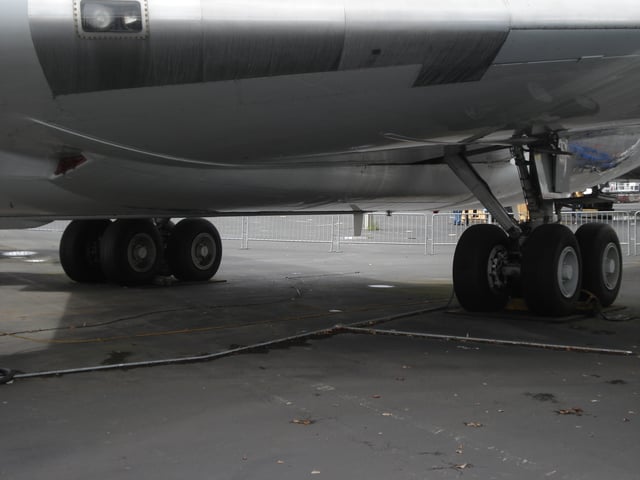
Four-wheel landing-gear bogies on a 707–120
The 707's wings are swept back at 35°, and like all swept-wing aircraft, display an undesirable "Dutch roll" flying characteristic that manifests itself as an alternating yawing and rolling motion. Boeing already had considerable experience with this on the B-47 and B-52, and had developed the yaw damper system on the B-47 that would be applied to later swept-wing configurations like the 707. However, many novice 707 pilots had no experience with this phenomenon, as they were transitioning from straight-wing propeller-driven aircraft such as the Douglas DC-7 and Lockheed Constellation.
On one customer-acceptance flight, where the yaw damper was turned off to familiarize the new pilots with flying techniques, a trainee pilot's actions violently exacerbated the Dutch roll motion and caused three of the four engines to be torn from the wings. The plane, a brand new 707-227, N7071, destined for Braniff, crash-landed on a river bed north of Seattle at Arlington, Washington, killing four of the eight occupants.[23]
In his autobiography, test pilot Tex Johnston describes a Dutch roll incident he experienced as a passenger on an early commercial 707 flight. As the aircraft's movements did not cease and most of the passengers became ill, he suspected a misrigging of the directional autopilot (yaw damper). He went to the cockpit and found the crew unable to understand and resolve the situation. He introduced himself and relieved the ashen-faced captain, who immediately left the cockpit feeling ill. Johnston disconnected the faulty autopilot and manually stabilized the plane "with two slight control movements".[24]
Engines
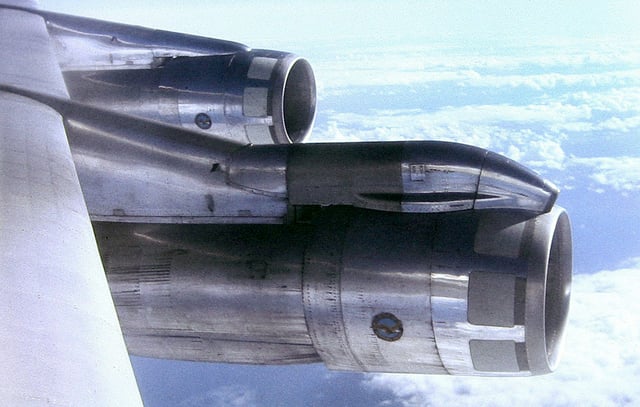
View of number 1 (top left) and 2 (center) Pratt & Whitney JT3D engines on the port side of a Boeing 707-320C: The number 1 engine mount does not have the "hump" for a pressurization turbocompressor.
The 707 uses engine-driven turbocompressors to supply compressed air for cabin pressurization. On many commercial 707s, the outer port (number 1) engine mount is distinctly different from the other three, as this engine is not fitted with a turbocompressor. Later-model 707s typically had this configuration, although American Airlines had turbocompressors on engines 2 and 3 only. Early 707 models often had turbocompressor fairings on all four engines, but with only two or three compressors installed.[25]
The JT3D-3B engines are readily identifiable by the large gray secondary air inlet doors in the nose cowl. These doors are fully open (sucked in at the rear) during takeoff to provide additional air. When the engines are throttled back to cruise, the doors are shut.
The 707 was the first commercial jet aircraft to be fitted with clamshell-type thrust reversers on each of the four engines.[26]
Upgraded engines
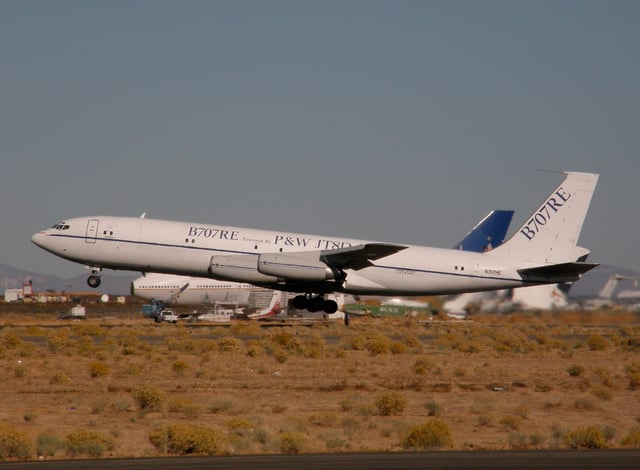
Omega Air's 707-330C testbed for the 707RE program takes off from the Mojave Airport
Pratt & Whitney, in a joint venture with Seven Q Seven (SQS) and Omega Air, has selected the JT8D-219 as a re-engine powerplant for Boeing 707-based aircraft, calling their modified configuration a 707RE.[27] Northrop Grumman has selected the -219 to re-engine the United States Air Force's fleet of 19 E-8 Joint STARS aircraft, which will allow the J-STARS more time on station due to the engine's greater fuel efficiency. NATO also plans to re-engine their fleet of E-3 Sentry AWACS aircraft. The -219 is publicized as being half the cost of the competing 707 re-engine powerplant, the CFM International CFM56, and is 40 dB quieter than JT3D engines that are being replaced.[27]
Operational history
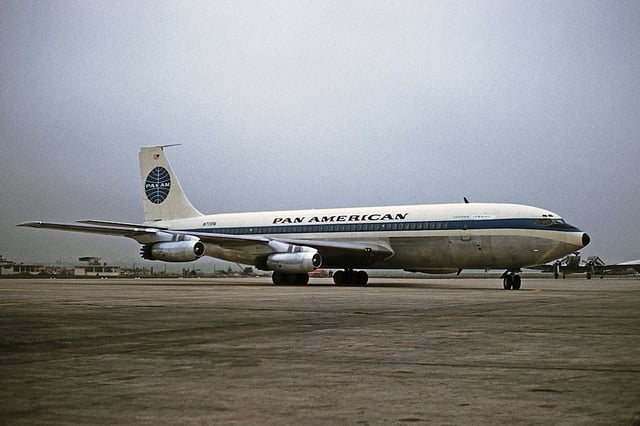
Pan Am's Jet Clipper America, a 707-121, at Paris–Le Bourget Airport after completing the first commercial flight of the 707 in October 1958
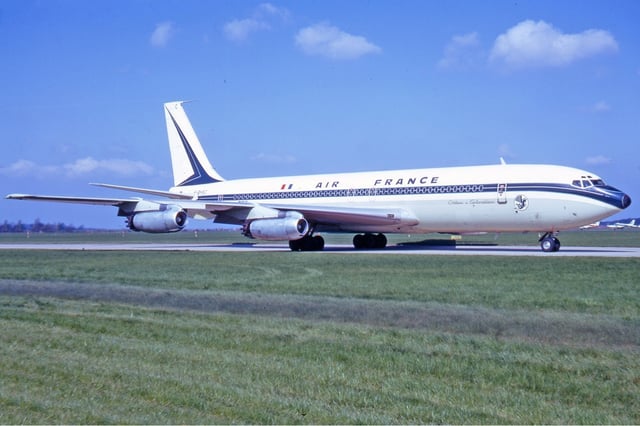
An Air France Boeing 707–328 at Hannover-Langenhagen Airport, 1972

Saha Airlines 707 landing at Tehran-Mehrabad in 2011: Saha Airlines was the last commercial operator of the 707.
The first commercial orders for the 707 came on October 13, 1955,[28] when Pan Am committed to 20 Boeing 707s and 25 Douglas DC-8s, dramatically increasing their passenger capacity (in available revenue passenger seat-miles per hour/per day) over its existing fleet of propeller aircraft. The competition between the 707 and DC-8 was fierce. Pan American ordered these planes, when and as they did, so that they would be the operators of the "first-off" production line for each aircraft type. Until their initial batch of the aircraft had been delivered to them and put into operation, Pan American would have the distinction of being not only the "Launch Customer" for both transcontinental American jets, but the exclusive operator of American intercontinental jet transports for at least a year.
The only rival in intercontinental jet aircraft production at the time was the British de Havilland Comet. However, this was never real competition for the American market as the Comet series had been the subject of fatal accidents (due to design flaws) early in its introduction, withdrawn from service, virtually redesigned from scratch, and reintroduced as version -4. It was also smaller and slower than the 707. Several major airlines committed only to the (second place in the production race) Douglas DC-8. Douglas Aircraft was the more established and preferred (by airlines and their passengers) maker of passenger aircraft at the time. Douglas had correctly decided to await the validation of a larger and more fuel efficient engine (Pratt & Whitney JT4A) and to design a larger and longer range aircraft around this engine. To stay competitive, Boeing made a late and costly decision to redesign and enlarge the 707's wing to help increase range and payload. The new version was numbered 707-320.[29]
Pan Am was the first airline to operate the 707; the carrier inaugurated 707 service with a christening at National Airport on October 17, 1958, attended by President Eisenhower, followed by a transatlantic flight for VIPs (personal guests of founder Juan Trippe) from Baltimore's Friendship International Airport to Paris.[30] The aircraft's first commercial flight was from Idlewild Airport, New York, to Le Bourget, Paris, on October 26, 1958, with a fuel stop in Gander, Newfoundland. In December, National Airlines operated the first U.S. domestic jet airline flights between New York/Idlewild and Miami, using 707s leased from Pan Am; American Airlines was the first domestic airline to fly its own jets, on January 25, 1959. TWA started domestic 707-131 flights in March and Continental Airlines started 707-124 flights in June; airlines that had ordered only the DC-8, such as United, Delta, and Eastern, were left without jets until September and lost market share on transcontinental flights. Qantas was the first non-US airline to use the 707s, starting in 1959.[31][32]
The 707 quickly became the most popular jetliner of its time. Its popularity led to rapid developments in airport terminals, runways, airline catering, baggage handling, reservations systems, and other air transport infrastructure. The advent of the 707 also led to the upgrading of air traffic control systems to prevent interference with military jet operations.[33]
As the 1960s drew to a close, the exponential growth in air travel led to the 707 being a victim of its own success. The 707 was now too small to handle the increased numbers of passengers on the routes for which it was designed. Stretching the fuselage was not a viable option because the installation of larger, more powerful engines would need a larger undercarriage, which was not feasible given the design's limited ground clearance at takeoff. Boeing's answer to the problem was the first wide-body airliner—the Boeing 747. The 707's first-generation engine technology was also rapidly becoming obsolete in the areas of noise and fuel economy, especially after the 1973 oil crisis.
In 1982, during the Falklands War, the Argentine Air Force extensively used 707s for long-range maritime patrol, with some of them being intercepted and shepherded away by Royal Navy Sea Harriers,[34] it also led to the conversion of British Nimrods to carry Sidewinder air-to-air missiles after a casual encounter.
Operations of the 707 were threatened by the enactment of international noise regulations in 1985. Shannon Engineering of Seattle developed a hush kit with funding from Tracor, Inc, of Austin, Texas. By the late 1980s, 172 Boeing 707s had been equipped with the Quiet 707 package. Boeing acknowledged that more 707s were in service than before the hush kit was available.[35]
Trans World Airlines flew the last scheduled 707 flight for passengers by a US carrier on October 30, 1983,[36] although 707s remained in scheduled service by airlines from other nations for much longer. Middle East Airlines of Lebanon flew 707s and 720s in front-line passenger service until the end of the 1990s. Since LADE of Argentina took its 707-320Bs from regular service in 2007, Saha Airlines of Iran was the last airline to keep 707s in scheduled passenger service until April 2013,[37] though it continued to use them for charter cargo flights until 2019, when their final 707 on lease crashed.[38]
As of 2019, only a handful of 707s remain in operation, acting as military aircraft for aerial refueling, transport, and AWACS missions.[39]
Variants
Although certified as Series 100s, 200s, 300s, etc., the different 707 variants are more commonly known as Series 120s, 220s, 320s, and so on, where the "20" part of the designation is Boeing's "customer number" for its development aircraft.
707-020
The 707-020 was the original designation for what ultimately became the Boeing 720. Launch customer United Air Lines was a Douglas DC-8 customer and preferred not to be seen as buying the competing 707, hence the 720 designation. American Airlines always referred to its 720s as 707s.
707-120
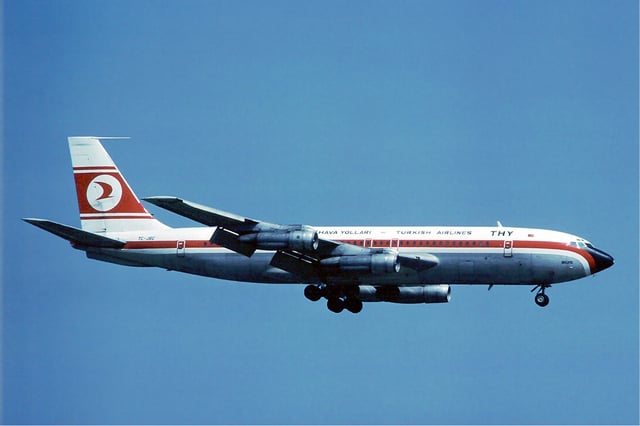
Turkish Airlines 707-121B in 1976

A 707-120B (VC-137B) wing, showing the new inboard leading edge like the 720s at Museum of Flight, Seattle, 2009.
The 707-120 was the first production 707 variant, with a longer, wider fuselage, and greater wingspan than the Dash 80. The cabin had a full set of rectangular windows and could seat up to 189 passengers.[40] It was designed for transcontinental routes, and often required a refueling stop when flying across the North Atlantic. It had four Pratt & Whitney JT3C-6 turbojets, civilian versions of the military J57, initially producing 13,000 lbf (57.8 kN) with water injection. Maximum takeoff weight was 247,000 lb (112,000 kg) and first flight was on December 20, 1957. Major orders were the launch order for 20 707-121 aircraft by Pan Am and an American Airlines order for 30 707-123 aircraft. The first revenue flight was on October 26, 1958;[41] 56 were built, plus seven short-bodied -138s; the last -120 was delivered to Western in May 1960.
The 707-138 was a -120 with a fuselage 10 ft (3.0 m) shorter than the others, with 5 ft (1.5 m) (three frames) removed ahead and behind the wing, giving increased range. Maximum takeoff weight was the same 247,000 lb (112,000 kg) as the standard version. It was a variant for Qantas, thus had its customer number 38. The seven -138s were delivered to Qantas between June and September 1959, and first carried passengers in July of that year.
The 707-120B had Pratt & Whitney JT3D-1 turbofan engines, which were quieter, more powerful, and more fuel-efficient, producing 17,000 lbf (75.6 kN) each, with the later JT3D-3 version giving 18,000 lbf (80 kN). (This thrust did not require water injection, eliminating both the system and 5000–6000 lb of water.) The -120B had the wing modifications introduced on the 720 and a longer tailplane; a total of 72 were built, 31 for American and 41 for TWA, plus six short-bodied -138Bs for Qantas. American had its 23 surviving -123s converted to -123Bs, but TWA did not convert its 15 -131s. The only other conversions were Pan American's five surviving -121s and one surviving -139, the three aircraft delivered to the USAF as -153s and the seven short-bodied Qantas -138s. The first flight of the -120B was on June 22, 1960, and American carried the first passengers in March 1961; the last delivery was to American in April 1969. Maximum weight was 258,000 lb (117,000 kg) for both the long- and short-bodied versions.
707-220
The 707-220 was designed for hot and high operations with more powerful 15,800 lbf (70.3 kN) Pratt & Whitney JT4A-3 turbojets. Five of these were produced, but only four were ultimately delivered, with one being lost during a test flight. All were for Braniff International Airways and carried the model number 707-227; the first entered service in December 1959. This version was made obsolete by the arrival of the turbofan-powered 707-120B.
707-320
The 707-320 Intercontinental is a stretched version of the turbojet-powered 707-120, initially powered by JT4A-3 or JT4A-5 turbojets producing 15,800 lbf (70.3 kN) each (most eventually got 17,500 lbf (77.8 kN) JT4A-11s). The interior allowed up to 189 passengers, the same as the -120 and -220 series, but improved two-class capacity due to an 80-in fuselage stretch ahead of the wing (from 138 ft 10 in (42.32 m) to 145 ft 6 in (44.35 m) ), with extensions to the fin and horizontal stabilizer extending the aircraft's length further.[42] The longer wing carried more fuel, increasing range by 1,600 miles (2,600 km) and allowing the aircraft to operate as true transoceanic aircraft. The wing modifications included outboard and inboard inserts, as well as a kink in the trailing edge to add area inboard.[22] Takeoff weight was increased to 302,000 lb (137,000 kg) initially and to 312,000 lb (142,000 kg) with the higher-rated JT4As and center section tanks. Its first flight was on January 11, 1958; 69 turbojet 707-320s were delivered through January 1963, the first passengers being carried (by Pan Am) in August 1959.
707-420
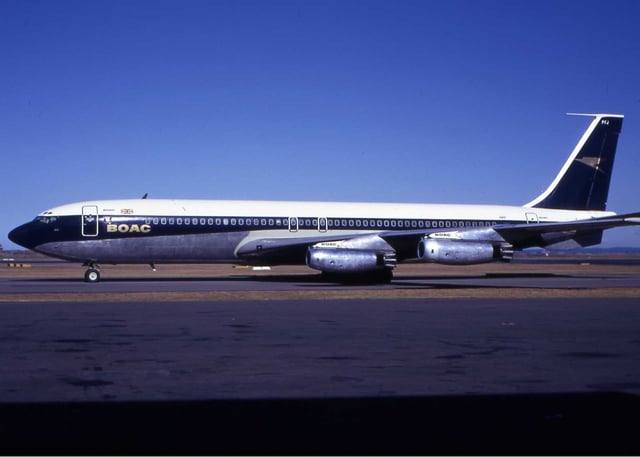
Conway-powered BOAC 707-436 at Sydney Airport in 1970
The 707-420 was identical to the -320, but fitted with Rolls-Royce Conway 508 (RCo.12) turbofans (or by-pass turbojets as Rolls-Royce called them) of 18,000 lbf (80 kN) thrust each.[43] The first announced customer was Lufthansa. BOAC's controversial order was announced six months later, but the British carrier got the first service-ready aircraft off the production line. The British Air Registration Board refused to give the aircraft a certificate of airworthiness, citing insufficient lateral control, excessive rudder forces, and the ability to over-rotate on takeoff, stalling the wing on the ground (a fault of the de Havilland Comet 1). Boeing responded by adding 40 inches to the vertical stabilizer, applying full instead of partial rudder boost, and fitting an underfin to prevent over-rotation. These modifications except to the fin under the tail became standard on all 707 variants and were retrofitted to all earlier 707s. The 37 -420s were delivered to BOAC, Lufthansa, Air-India, El Al, and Varig through November 1963; Lufthansa was the first to carry passengers, in March 1960.
707-320B
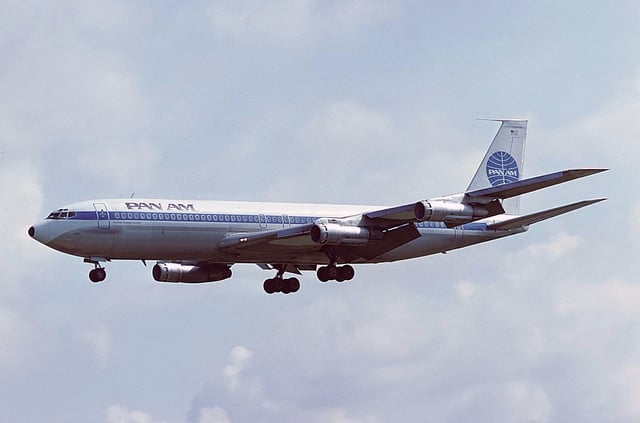
A Boeing 707-320B of Pan American World Airways in 1979
The 707-320B had the application of the JT3D turbofan to the Intercontinental, but with aerodynamic refinements. The wing was modified from the -320 by adding a second inboard kink, a dog-toothed leading edge, and curved low-drag wingtips instead of the earlier blunt ones.[22] These wingtips increased overall wingspan by 3.0 ft. Takeoff gross weight was increased to 328,000 lb (149,000 kg). The 175 707-320B aircraft were all new-build; no original -320 models were converted to fan engines in civilian use. First service was June 1962, with Pan Am.
The 707-320B Advanced is an improved version of the -320B, adding the three-section leading-edge flaps already seen on the -320C. These reduced takeoff and landing speeds and altered the lift distribution of the wing, allowing the ventral fin found on earlier 707s to be deleted. From 1965, -320Bs had the uprated -320C undercarriage allowing the same 335,000 lb (152,000 kg) MTOW. These were often identified as 707-320BA-H.
707-320C

Ecuatoriana de Aviación 707-321C in January 1987
The 707-320C has a convertible passenger–freight configuration, which became the most widely produced variant of the 707. The 707-320C added a strengthened floor and a new cargo door to the -320B model. The wing was fitted with three-section leading-edge flaps which allowed the deletion of the underfin. A total of 335 of this variant were built, including some with JT3D-7 engines (19,000 lbf (85 kN) takeoff thrust) and a takeoff weight of 335,000 lb (152,000 kg). Most -320Cs were delivered as passenger aircraft with airlines hoping the cargo door would increase second-hand values. The addition of two additional emergency exits, one on either side aft of the wing raised the maximum passenger limit to 219. Only a few aircraft were delivered as pure freighters. One of the final orders was by the Iranian Government for 14 707-3J9C aircraft capable of VIP transportation, communication, and in-flight refueling tasks.
707-700
The 707-700 was a test aircraft used to study the feasibility of using CFM International CFM56 engines on a 707 airframe and possibly retrofitting existing aircraft with the engine. After testing in 1979, N707QT, the last commercial 707 airframe, was restored to 707-320C configuration and delivered to the Moroccan Air Force as a tanker aircraft via a "civilian" order. Boeing abandoned the retrofit program, since it felt it would be a threat to the Boeing 757 program. The information gathered from testing led to the eventual retrofitting of CFM56 engines to the USAF C-135/KC-135R models, and some military versions of the 707 also used the CFM56. The Douglas DC-8 "Super 70" series with CFM56 engines was developed and extended the DC-8's life in a stricter noise regulatory environment. So, more DC-8s than 707s are in service now.
Other variants
The 707-620 was a proposed domestic range-stretched variant of the 707-320B. The 707-620 was to carry around 200 passengers while retaining several aspects of the 707-320B. It would have been delivered around 1968 and would have also been Boeing's answer to the stretched Douglas DC-8 Series 60. Had the 707-620 been built, it would have cost around US$8,000,000.[44] However, engineers discovered that a longer fuselage and wing meant a painstaking redesign of the wing and landing-gear structures. Rather than spend money on upgrading the 707, engineer Joe Sutter stated the company "decided spending money on the 707 wasn't worth it". The project was cancelled in 1966 in favor of the newer Boeing 747.[45]
The 707-820 was a proposed intercontinental stretched variant of the 707-320B. It was to be powered by four Pratt & Whitney JT3D-15 turbofan engines and would have had a 10-foot (3.0 m) extension in wingspan. Two variations were proposed, the 707-820(505) model and the 707-820(506) model. The 505 model would have had a fuselage 45 feet (14 m) longer than the 707-320B and would have carried 209 passengers in mixed-class configuration and 260 passengers in all-economy configuration. The 506 model would have had a fuselage 55 feet (17 m) longer than the 707-320B and would have carried 225 passengers in mixed class configuration and 279 passengers in all economy configuration. Like the 707-620, the 707-820 was also set to compete with the stretched DC-8-60 Super Series models. The design was being pitched to American, TWA, BOAC, and Pan Am at the time of its proposal in early 1965.[46] The 707-820 would have cost US$10,000,000.[44] Like the 707-620, the 707-820 would have required a massive structural redesign to the wing and gear structures. The 707-820 was also cancelled in 1966 in favor of the 747.[45]
Military
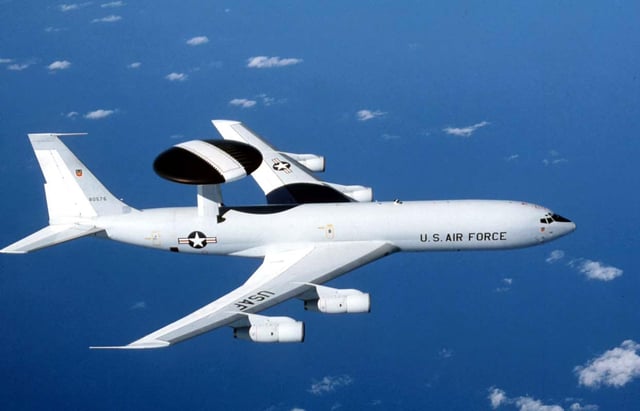
USAF E-3 Sentry in flight, 2002

RAAF 707-368C at Perth International Airport, Australia, 2004
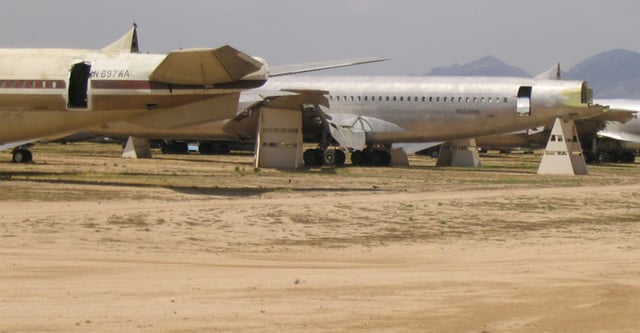
Boeing 707s at AMARG being used for salvage parts for the KC-135s, 2005
The militaries of the US and other countries have used the civilian 707 aircraft in a variety of roles, and under different designations. (The 707 and U.S. Air Force's KC-135 were developed in parallel from the Boeing 367–80 prototype.)
The Boeing E-3 Sentry is a US military airborne warning and control system (AWACS) aircraft based on the Boeing 707 that provides all-weather surveillance, command, control, and communications.
The VC-137C variant of the Stratoliner was a special-purpose design meant to serve as Air Force One, the secure transport for the President of the United States. These models were in operational use from 1962 to 1990. The two aircraft remain on display: SAM 26000 is at the National Museum of the United States Air Force near Dayton, Ohio and SAM 27000 is at the Ronald Reagan Presidential Library in Simi Valley, California.
The Canadian Forces also operated the Boeing 707 with the designation CC-137 Husky (707-347C) from 1971 to 1997.
717
Boeing 717 was the company designation for C-135 Stratolifter and KC-135 Stratotanker derivatives of the 367-80. The designation was later reused in renaming the McDonnell Douglas MD-95 to Boeing 717 after the company was merged with Boeing.
Operators
Boeing's customer codes used to identify specific options and livery specified by customers was started with the 707, and has been maintained through all Boeing's models. In essence the same system as used on the earlier Boeing 377, the code consisted of two digits affixed to the model number to identify the specific aircraft version. For example, Pan American World Airways was assigned code "21". Thus, a 707-320B sold to Pan Am had the model number 707-321B. The number remained constant as further aircraft were purchased; thus, when Pan American purchased the 747-100, it had the model number 747-121.
In the 1980s, the USAF acquired around 250 used 707s to provide replacement turbofan engines for the KC-135E Stratotanker program.[47]
The 707 is no longer operated by major airlines. American actor John Travolta owned an ex-Qantas 707-138B, with the registration N707JT. In May 2017, he donated the plane to the Historical Aircraft Restoration Society near Wollongong, Australia. The plane was to be flown to Illawarra Regional Airport, where HARS is based, once repairs to ensure safe flying condition have been completed.[48]
Orders and deliveries
Deliveries
| Total | 1994 | 1993 | 1992 | 1991 | 1990 | 1989 | 1988 | 1987 | 1986 | 1985 | 1984 | 1983 | 1982 | 1981 | 1980 | 1979 | 1978 | 1977 | 1976 |
|---|---|---|---|---|---|---|---|---|---|---|---|---|---|---|---|---|---|---|---|
| 1010 | 1 | 0 | 5 | 14 | 4 | 5 | 0 | 9 | 4 | 3 | 8 | 8 | 8 | 2 | 3 | 6 | 13 | 8 | 9 |
| 1975 | 1974 | 1973 | 1972 | 1971 | 1970 | 1969 | 1968 | 1967 | 1966 | 1965 | 1964 | 1963 | 1962 | 1961 | 1960 | 1959 | 1958 | 1957 | 1956 |
| 7 | 21 | 11 | 4 | 10 | 19 | 59 | 111 | 118 | 83 | 61 | 38 | 34 | 68 | 80 | 91 | 77 | 8 | 0 | 0 |
707 Model summary
| Model Series | Orders | Deliveries |
|---|---|---|
| 707-120 | 56 | 56 |
| 707-120B | 72 | 72 |
| 707-138 | 7 | 7 |
| 707-138B | 6 | 6 |
| 707-220 | 5 | 5 |
| 707-320 | 69 | 69 |
| 707-320B | 174 | 174 |
| 707-320C | 337 | 337 |
| 707-420 | 37 | 37 |
| 707-E3A | 57 | 57 |
| 707-E3D | 7 | 7 |
| 707-E3F | 4 | 4 |
| 707-E6A | 17 | 17 |
| 707-KE3 | 8 | 8 |
| 720-000 | 65 | 65 |
| 720-000B | 89 | 89 |
| 707 Total | 1010 | 1010 |
Boeing[49]
Accidents and incidents
Aircraft on display
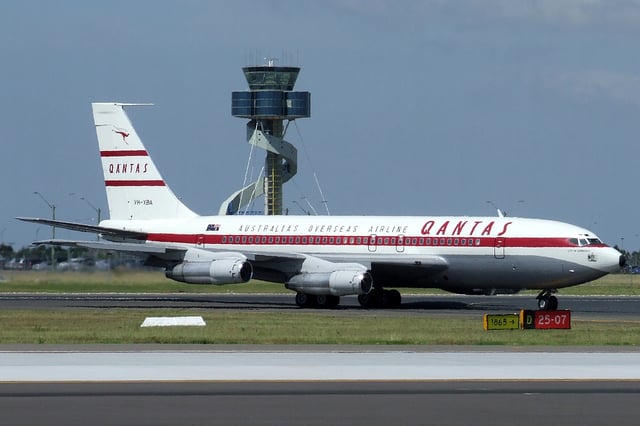
Ex-Qantas Boeing 707-138B VH-XBA undergoing taxi tests in 2007 at Sydney International Airport prior to its delivery to the Qantas Founders Outback Museum

Retired South African Air Force Boeing 707-328C at the South African Air Force Museum, Pretoria
VH-XBA model 707-138B (number 29) is one of the first 707s exported, and the first civilian jet registered in Australia (to airline Qantas in 1959); it is on display at the Qantas Founders Outback Museum in Longreach, Queensland, Australia.[53]
4X-BYD model 707-131(F), (number 34), an ex-Israeli Air Force and TWA aircraft, is on display at the Israeli Air Force Museum near Hatzerim, Israel.[54]
4X-JYW model 707-328 (msn. 173617, number 110), is a former Air France (F-BHSE) aircraft sold to the Israeli Air Force; it is on display at the Israeli Air Force Museum, Beersheba – Hatzerim (LLHB).[55]
G-APFJ model 707-436 (msn. 17711, number 163) is a forward fuselage on display at the National Museum of Flight, East Fortune, in BOAC livery.[56]
D-ABOB model 707-430 (msn. 17720, number 115) is a former Lufthansa airliner on display at Hamburg Airport (HAM/EDDH); it was originally registered as D-ABOD.[57]
D-ABOF model 707-430 (msn. 17721, number 162), was formerly operated by Lufthansa. Its nose section is preserved at the Deutsches Museum in Munich.[58]
N130KR model 707-458 (msn. 18071, number 216) is a former El Al (4X-ATB) aircraft restored in 1960s Lufthansa markings with fictitious registrationD-ABOC previously displayed at Berlin – Tegel (TXL/EDDT); it is now parked at the edge of the airfield.[59]
CC-CCG model 707-330B (msn. 18642, number 233), an ex-Lufthansa and LAN Chile craft, is undergoing restoration at Santiago – Los Cerillos, Chile (ULC/SCTI) and will be repainted in the Chilean airline's 1960s scheme.[60]
F-BLCD model 707-328B (number 471) is on display at the Musée de l'Air et de l'Espace, Paris, France.[61]
EP-IRJ model 707-321B (msn. 18958, number 475), a former Iran Air aircraft, was originally delivered to Pan American as N416PA, and is currently the Air Restaurant at Mehrabad Airport, Tehran.[62]
A20-627 model 707-338C (msn. 19627, number 707) flew with the RAAF. Originally delivered to Qantas as VH-EAG, its forward fuselage is preserved at the Historical Aircraft Restoration Society, Albion Park Rail, New South Wales, Australia.[63]
1419 model 707-328C (msn. 19917, number 763), an ex-SAAF aircraft, is on display at the South African Air Force Museum – Swartkop Air Force Base, Pretoria.[64]
N893PA model 707-321B (msn. 20030, number 791), a former CAAC aircraft originally delivered to Pan American, is preserved at Tianjin, China.[65]
HZ-HM2 Model 707-386C (msn. 21081, number 903) is a Saudi Air Force VIP aircraft painted in the current Saudia color scheme; delivered in 1975, it is registered as HZ-HM1 and preserved at the Saudi Air Force Museum, Riyadh.[66]
Specifications
| Variant | 707-120B | 707-320/-420 | 707-320B | 707-320C |
|---|---|---|---|---|
| Cockpit crew[67] | Three minimum: Pilot, Copilot, and Flight Engineer | |||
| 1-Class/cargo:16–18 | 174 @ 34" | 189 @ 34" | 194 @ 32" | |
| 2-class/cargo:16–18 | 137 (32J @ 38" + 105Y @ 34") | 141 (18J + 123Y) | 13 88×125" pallets | |
| Exit Limit[67] | 189 | 219 | ||
| Length:5 | 145 ft 1 in (44.22 m) | 152 ft 11 in (46.61 m) | ||
| Fuselage width:19 | 148 in / 3.759 m | |||
| Wingspan:5 | 130 ft 10 in (39.88 m) | 142 ft 5 in (43.41 m) | 145 ft 9 in (44.42 m) | |
| Tail height:5 | 41 ft 8 in (12.70 m) | 42 ft 2 in (12.85 m) | 42 ft 1 in (12.83 m) | 42 ft 0 in (12.80 m) |
| MTOW:9 | 257,340 lb / 117 t | 312,000 lb / 141.7 t | 333,600 lb / 151.5 t | |
| OEW:9 | 127,500 lb / 57.6 t[1] | 142,600 lb / 64.6 t[2] | 148,800 lb / 67.5 t[2] | 148,300 lb / 67.3 t[3] |
| Fuel capacity:9 | 17,330USgal / 65.59 m3 | 23,820USgal / 90.16 m3 | 23,855 USgal / 90.29 m3 | |
| Engines (x4):36 | Pratt & Whitney JT3D-3 | -320 : Pratt & Whitney JT4A-11/12 -420: Rolls-Royce Conway-12 | Pratt & Whitney JT3D | |
| Thrust per engine:36–41 | 18,000 lbf (80 kN) | 17,500 lbf (78 kN) | 19,000 lbf (85 kN) | |
| Cruise | 528 kn; 607 mph (977 km/h)[68] | |||
| Range:30–34 | 3,600 nmi (6,700 km; 4,100 mi)[4] | 3,750 nmi (6,940 km; 4,320 mi)[5] | 5,000 nmi (9,300 km; 5,800 mi)[5] | 2,900 nmi (5,400 km; 3,300 mi)[6] |
| Takeoff | 7,500 ft (2.3 km) | 10,700 ft (3.25 km) | 10,000 ft (3.0 km) | |
| Landing[7]:42–46 | 6,500 ft (2.0 km) | 7,200 ft (2.2 km) | 5,900 ft (1.8 km) | 6,200 ft (1.9 km) |
See also
Aircraft in fiction, Boeing 707
Related development
Boeing 367-80
KC-135 Stratotanker
Boeing 720
Aircraft of comparable role, configuration and era
de Havilland Comet
Convair 880
Douglas DC-8
Ilyushin Il-62
Shanghai Y-10
Tupolev Tu-114
Vickers VC10
Related lists
List of jet airliners